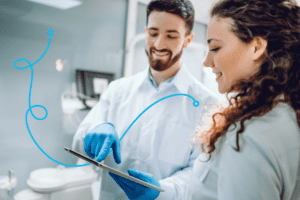Clear and effective communication is essential to providing high-quality care to all patients. But what happens when there’s a language barrier in patient communications?
In this blog post, we’ll discuss the challenges of language barriers in dental patient communications and provide tips on how dental practices can overcome these barriers to ensure that all patients receive the care they need. From utilizing translation services to providing written materials in multiple languages, we’ll cover the strategies that can help your practice provide better care and build stronger relationships with all of your patients. Join us as we explore this important topic and learn how to provide care that transcends language barriers.
The Challenges of Language Barriers in Patient Communications

Dental practices face numerous challenges when communicating with patients who speak different languages, including:
Misunderstandings and Miscommunication: Language barriers can lead to misunderstandings and miscommunication between dental staff and patients, which can result in incorrect diagnoses, inappropriate treatment recommendations, and even medical errors.
Limited Access to Care: Patients who are unable to communicate effectively with dental staff may be less likely to schedule appointments and follow through with treatment plans, limiting their access to essential care.
Reduced Patient Satisfaction and Trust: Poor communication can lead to frustration and reduced satisfaction for patients, which in turn can negatively impact their trust in the dental practice. This can have long-term consequences, such as patients not returning for future appointments or not recommending the practice to others.
Tips for Overcoming Language Barriers in Patient Communications
To overcome language barriers in patient communications, dental practices can consider the following strategies:
Utilizing Translation Services and Technology: Partner with professional translation services to assist with patient communications or use technology, such as translation apps and software, to facilitate communication between dental staff and patients.
Providing Written Materials in Multiple Languages: Offer written materials, such as consent forms, treatment plans, and educational resources, in multiple languages to ensure that all patients can understand and access important information.
Implementing Patient Engagement Software: Choose a patient engagement software, like Intiveo, that is capable of sending messages in different languages. Intiveo can translate patient communications into English, Spanish, French, and Chinese (Traditional), making it easier for dental practices to effectively communicate with their diverse patient populations.
Hiring Bilingual Staff: Employ bilingual staff members who can communicate effectively with patients in their native languages, helping to bridge the communication gap.
Providing Cultural Training to Staff: Offer cultural competency training for dental staff to increase their understanding of different cultural norms and expectations around dental care, helping them to better serve patients from diverse backgrounds.
Encouraging Patient Feedback and Input: Solicit feedback from patients regarding their experiences with language barriers and use this information to make improvements to your practice’s communication strategies.
The Benefits of Overcoming Language Barriers in Patient Communications

Overcoming language barriers in dental patient communications can lead to numerous benefits, such as:
Improved Patient Experience and Trust: By addressing language barriers and improving communication, dental practices can enhance patient experience and build trust, which can encourage patients to return for future appointments and recommend the practice to others.
Increased Access to Care: When patients feel understood and well-informed, they are more likely to schedule appointments and follow through with treatment plans, ultimately improving their access to essential dental care.
Better Health Outcomes: Clear communication between dental staff and patients can result in more accurate diagnoses, appropriate treatment recommendations, and better adherence to treatment plans, leading to improved health outcomes for patients.
Positive Reviews and Referrals: Satisfied patients are more likely to leave positive reviews online and refer friends and family to the practice, helping to grow the patient base and improve the reputation of the dental practice.
Real-Life Examples of Overcoming Language Barriers in Dental Patient Communications
There are numerous examples of dental practices that have successfully overcome language barriers in their patient communications. These practices have implemented strategies like hiring bilingual staff, offering written materials in multiple languages, and using translation services to ensure clear communication with their diverse patient populations. As a result, these practices have experienced improvements in patient satisfaction, trust, and overall success.
One such example is a dental practice in a culturally diverse area that hired a team of bilingual dental professionals. These professionals were able to effectively communicate with patients in their native languages, resulting in a significant increase in patient satisfaction and trust. Additionally, this practice invested in cultural competency training for all staff members, further enhancing their ability to connect with and serve their diverse patient base.
Another example is a dental clinic that began providing written materials in multiple languages. By offering consent forms, treatment plans, and educational resources in the languages spoken by their patients, the clinic ensured that all patients had access to essential information. This approach not only improved patient understanding and satisfaction but also led to better adherence to treatment plans and improved health outcomes.
Conclusion

Overcoming language barriers in dental patient communications is crucial for providing high-quality care and building strong relationships with all patients. By implementing strategies such as utilizing translation services, providing written materials in multiple languages, hiring bilingual staff, offering cultural training, and encouraging patient feedback, dental practices can effectively address language barriers and improve the overall patient experience.
By focusing on overcoming language barriers, dental practices can not only provide better care but also foster stronger relationships with their diverse patient populations. This commitment to clear communication and cultural understanding can lead to increased patient experience, trust, and ultimately, the success and growth of the dental practice.





